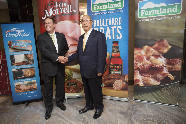To Be Different: Celebrity Photographer Andy Gotts Visits China
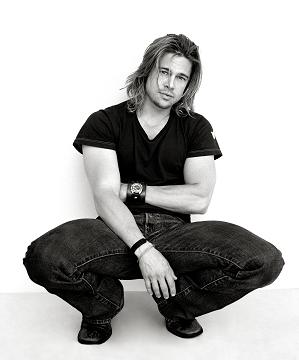
Brad Pitt |
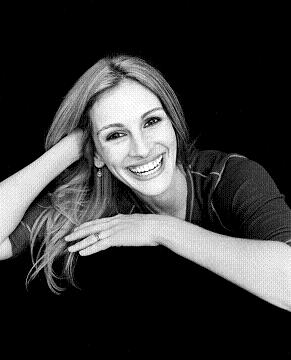 Julia Roberts |
|
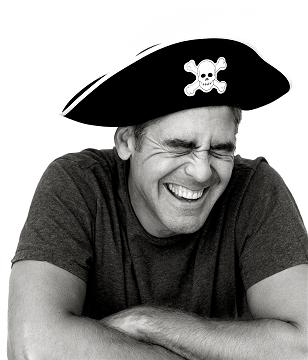 |
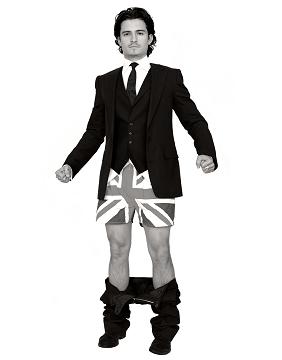 Orlando Bloom |
Photos by Andy Gotts
In 1994, Gotts fixed upon the idea of doing a project photographing all his heroes from the movies. "I wasn't sure how I could do it. At that time, I didn't have any links with Hollywood," Gotts said. Then he checked out the addresses of 300 British actors in a local library, and wrote pleading letters. For half a year he didn't get any responses.
Then one day, out of blue, his phone went off. It was Joss Ackland, an English actor, who said he would agree to have a portrait if Gotts only on the condition that he photographed his son's wedding first. Of course, Gotts said yes.
Hearing of Gotts' lack of progress, Ackland knew exactly why he wasn't getting any bites. He said the problem was that he didn't have a theme, and suggested "Who knows who", based on the parlor game "Six degrees of Kevin Bacon" and jumping from one celebrity's best friend to another. So Ackland started it off, phoning the actress Greta Scacchi, and then Scacchi phoned her best friend. Once one actor said "yes" it snowballed from there.
He spent the next few years going traveling England photographing every famous English actor. Then he journeyed to the United States to photograph famous stars in Hollywood. "Being able to sit down with those movie stars, Brat Pitt or George Clooney, it's a dream come true," Gotts said.
To Be Different
But Gotts couldn't have achieved his goal by contacts alone. Seasoned Hollywood stars are used to projecting an image for photographers. Gotts broke out of this mold. "They are actors. Most of the time they are asked to be somebody else," he explained. "99 percent of actors hate to be photographed in any way."
Gotts, however, has a talent for capturing the celebrities in an open and unadorned state, with just him and his camera and without any assistants or hair and makeup artists.
This novelty appeals to the stars he shoots, who are used to a dozen or more people fussing around the set. If they are asked to do something out of the ordinary, they're far more likely to say "no", put off by a room full of eyes all directed towards them.
His more intimate approach to shoots that allows Gotts to push boundaries with what his subjects will do, and he has no qualms about asking them to do what he wants. His attitude is that if you don't ask, you never know if they'll agree or not.
When he photographed George Clooney in the star's massive villa in Italy, Gotts wanted a white wall for backdrop so Clooney led him to a suitable bedroom. "In the middle of the bed was the pirate's hat," he recalled. "It was kind of bizarre, if you go into someone's bedroom the last thing you expect to see is a pirate's hat." When he asked about it, Clooney told him that he had thrown a hat party the day before, with stars like Michael Douglas attending and wearing their own silly hats.
"When I explained how silly he looked with the pirate hat on, he started," Gotts said. It was then that he took the now famous shot.
To capture the kind of natural moments, Gotts treats the celebrities like friends rather than stars, and they enjoy the novelty. This played to his advantage when he photographed Brad Pitt and was given only 11 minutes by the PR company of the film he was shooting at the time.
Brad appeared late and alone, and immediately launched into chit chat, talking about the weather and about how he liked Gotts' work. With three and a half minutes to go, Gotts suggested they had better start taking pictures, and Pitt responded that it was his movie, so he would decide how long it would take, not the PR company.
90 minutes passed, and they still were chatting, arm wrestling, and joking playfully. "Just like two brothers," Gotts said. When they finally got to taking photographs, Pitt was relaxed and pliable. "Everything I asked him to do, he did. He didn't say no or even think about it," Gotts said.
"At the time he had long hair droop down in front of his face, he ruffled his hair up so it looked a bit mad and he started laughing and crouching down in the corner," Gotts recalled. Then he took the photographs of Pitt crouching down against the wall. "He loved the effect. He looked like he did normally," Gotts said.
Gotts' devotion to philanthropy also makes him stand out. The proceeds from his book "Degrees," a collection of many of his celebrity portraits, were all donated to diabetes research.
Gotts told China Today how later he had received an email from a mother of a daughter who had diabetes. The girl had to undergo from injections twice a day. People made fun of her and bullied her. She was so depressed that she had attempted suicide several times.
Then one day she watched an interview with Gotts on television, talking about his work and about Hollywood stars devoting their time to help other people with diabetes like her. Suddenly she felt special and her spirits were lifted. Her academic performance improved and later she was qualified as a counselor so that she could help people who were experiencing the same suicidal feelings that she had. "When I got the email, I thought if it is the only thanks I'll ever get, every job I do is worthwhile," Gotts told China Today.
Currently, Gotts is devoted to another philanthropic project, "iCons", to raise funds for Elton John AIDS Foundation by shooting a series of legendary figures in Hollywood.
Suitable for China?
In his speech in Tsinghua University, Gotts emphasized three keys to his success: goal, passion and belief. According to Gotts, the goal is the destination, passion is the engine driving you toward your goal, and belief brings confidence to you in what you are doing.
"What I admire most about Gotts is not that he has made his dream come true, but his perseverance in seeking his dream and his western-style boldness and creativity, which many Chinese people lack," Zhang Qixiang, a photography graduate from Beijing Film Academy, told China Today after Gotts' lecture in Beijing.
Yue Jie, a longstanding Chinese portrait photographer, is more critical of Gotts' work. He feels that the humor and sometimes out of the ordinary behavior shown in his photographs are staged. Neither, he told China Today, does he think trying to unveil the real nature of celebrities in photographs is anything new. "We've always endorsed portraying the true and unique personality of a portrait's subject, so in this regard Gotts isn't original," he told China Today. Yue doesn't think that Gotts' style will gain a foothold in China and that its popularity is only a fad.
Gotts has his own opinion about the current art scene in the Middle Kingdom. "The way I see it is that Chinese artists fall into two groups," he says of his peers in China. "They're either producing very surreal and very fine art that's very different, or art that's very plain and safe. There isn't much in the middle."
No matter how diversified people's opinions are, what's definite is that in intercultural exchanges peoples of different cultures are learning from each other to create their own legends.
Gotts told China Today, although he had not a plan to photograph China's celebrities yet, he thought he would come back for a project later.

